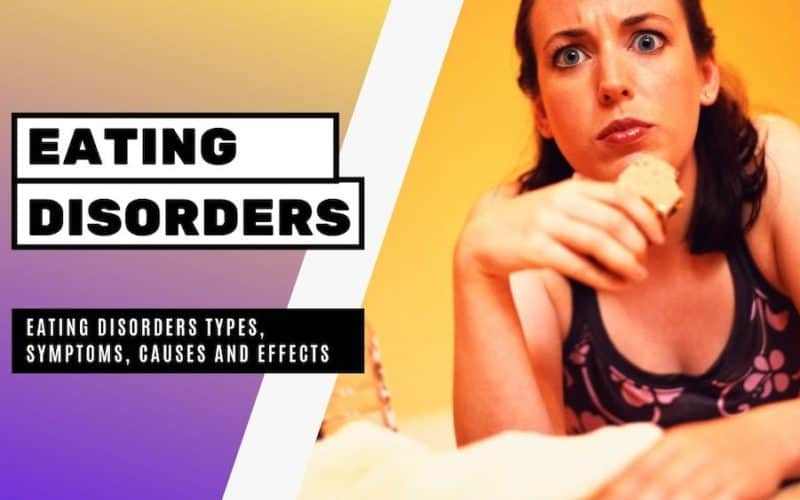Eating disorders are serious conditions that include constant eating behaviors that have a negative impact on health, emotions, and ability to function properly in everyday activities. Knowing the eating disorders types, symptoms, causes, and effects can help you to get the right type of care and help.
People with eating disorders tend to focus too much on weight, body shape, and food, which can lead to harmful eating patterns that do not provide the required nutrition to the bodies. Eating disorders often develop in late teenage or early adulthood, but can also develop at other ages.
Table of Contents
Types and Symptoms of Eating Disorders:
Base on the types of eating disorders, a person can see different symptoms. So below, we have listed symptoms base on the eating disorders sings.
1. Anorexia Nervosa
Anorexia nervosa can be said to be the most well-known eating disorder. Usually, it develops during adolescence or young adulthood and affects more women than men. Common symptoms include:
- Viewing themselves as overweight
- Very restricted diets
- Considerably underweight when compared with the recommended weight according to weight and age
- Fear of gaining weight
- Constant trying to avoid gaining weight
- Crazy about remaining thin, even if it means an unhealthy body weight
- Self-esteem and confidence are highly influenced by body weight
Anorexia is can further be divided into two subtypes such as the restricting type and the binge-eating and purging type. People with the restricting type lose weight only through dieting, fasting or intense exercise. Individuals with the binge-eating and purging type may eat a lot or too little, and use after eating.
2. Bulimia Nervosa
Bulimia nervosa is another well-known eating disorder in which people eat unusually large amounts of food in a relatively short period. People then try to purge to compensate for the intake of extra calories.
Individuals with bulimia then attempt to purge to compensate for the calories. Common symptoms of bulimia nervosa include:
- Binge eating
- Fear of gaining weight
- Self-confidence affected by weight
- Purging behavior
3. Binge eating disorder
Binge eating was only officially recognized as an eating disorder recently and is one of the most common disorders. Individuals with this disorder have similar symptoms to those with bulimia or the binge-eating subtype of anorexia.
People eat large amounts of food in a short time, that is, they binge eat, but do not engage in purging behaviors. Common symptoms of binge eating disorder include:
- Eating large amounts of food really quickly
- Lack of control when binge eating
- Feeling guilt or shame when thinking about binge eating
- Feeling a lack of control during episodes of binge eating.
4. Pica
People with pica crave non-food substances such as ice, dirt, soil, chalk, soap, paper, hair, cloth, wool, pebbles, laundry detergent or cornstarch. This disorder commonly diagnosed in children, pregnant women, and mentally disabled people, but can also affect any child or adult.
Pica can increase the risk of poisoning, infections, gut injuries, and nutrition deficiencies. Moreover, Pica may also be fatal at times if such a substance is ingested.
5. Rumination disorder
Rumination disorder is another newly recognized eating disorder, and it describes a condition in which a person regurgitates food they have previously chewed and swallowed, re-chews it and then either re-swallows it or spits it out. This rumination typically occurs within the first 30 minutes after a meal.
This disorder can develop during infancy, childhood, or adulthood. If not resolved in infants, rumination disorder can result in weight loss and severe malnutrition that can be fatal.
6. Avoidant or Restrictive food intake disorder
Avoidant or restrictive food intake disorder (ARFID) was previously known as ‘feeding disorder of infancy and early childhood.’ Although ARFID generally develops during infancy or early childhood, it can continue into adulthood.
People with this disorder have abnormal eating either due to a lack of interest in eating or a distaste for certain smells, tastes, colors, textures, or temperatures. Common symptoms include:
- Avoidance or restriction of food intake that prevents the person from eating sufficient calories or nutrients.
- Eating habits that interfere with social functions
- Weight loss
- Nutrient deficiencies
In addition to these, less common eating disorders also exist that can be categorized as follows:
Purging disorder: Individuals with this disorder often use purging behaviors, such as vomiting, laxatives, diuretics or excessive exercising, to control their weight or shape. However, they do not binge.
Night eating syndrome: Individuals with this syndrome frequently eat excessively, often after awakening from sleep.
Eating disorder not otherwise specified (EDNOS): This includes any other possible conditions that have symptoms similar to those of an eating disorder but don’t fit into any of the categories above.
Causes and Effects of Eating Disorders:
There is no clear cause of an eating disorder. However, there are several factors that can influence it. Such as
1. Biological
Studies have shown that eating disorders may be passed on to you through your family by inheritable genes.
2. Environmental
A person’s upbringing and surroundings can also trigger eating disorder symptoms. Examples include Traumatic experiences.
- Feelings of pressure to look a certain way
- Sports performance requirements
- Expectations about grades in school
- Family dynamics
- The pressure to be perfect
3. Cultural
The culture around us can also cause eating disorders. We are constantly exposed to beauty advertisements that promote unrealistic body images and unhealthy diets. This may lead to the onset of eating disorder symptoms.
Different types of eating disorders have different effects on our bodies and health.
Anorexia can greatly damage our bodies and lead to thinning of bones and brittle hair. Moreover, it can result in heart, brain, or multi-organ failure and death in severe cases.
Effects of bulimia may include an inflamed and sore throat, swollen salivary glands, worn tooth enamel, tooth decay, acid reflux, irritation of the gut, severe dehydration and hormonal disturbances.
In severe cases, bulimia can also create an imbalance in levels of electrolytes such as sodium, potassium, and calcium in our bodies which can cause a stroke or heart attack.
People with binge eating disorder are often overweight or obese. This may increase their risk of medical complications arising from excess weight, such as heart disease, stroke, and type 2 diabetes.
If you notice symptoms of an eating disorder in a friend or family member, try talking to the person about it. Encourage the person to seek medical consultation and treatment, by which they can return to healthier eating habits and sometimes even reverse the serious complications caused by the eating disorder.





